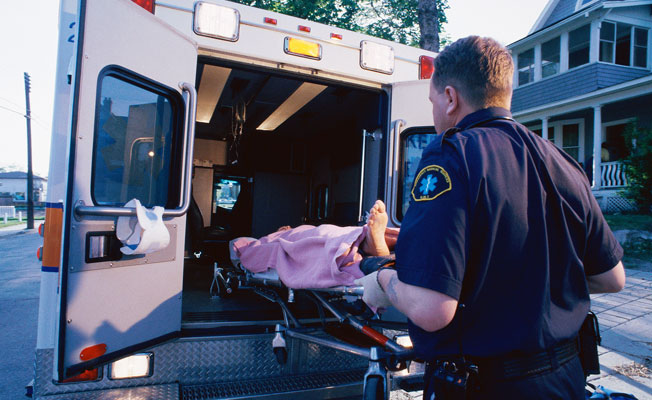Dr. Brian Grunau, CHÉOS Emergency Medicine Scientist, is developing the largest and most comprehensive dataset of opioid-related cardiac arrest cases in the world to identify the most effective resuscitation approach in these cases. Dr. Grunau’s project is funded through the MSFHR Health Professional-Investigator Program.
Between January 2016 and September 2018, over 10,000 Canadians died due to opioid overdose. An opioid overdose causes an individual to decrease breathing efforts. Interventions to assist breathing, like rescue breaths, and administration of naloxone can reverse these effects. However, if these measures are not performed or are unsuccessful, a person’s heart can stop (“cardiac arrest”). Once this occurs, it is unclear which resuscitation methods are optimal.

“The overarching problem in providing treatment guidelines for these cases is that there is a lack of data available to make evidence-based recommendations,” noted Dr. Grunau.
Opioid-related cardiac arrests are distinct from other types of cardiac arrest but current databases do not identify if opioids were involved in a cardiac arrest, nor is information collected about opioid-related bystander interventions such as naloxone. As a result, there is not enough information to fully understand how best to respond to a cardiac arrest caused by an opioid overdose.
Evidence-Based Bystander CPR
One of the main points of confusion is whether or not rescue breaths should be used during cardiopulmonary resuscitation (CPR). Current guidelines recommend compression-only CPR for cardiac arrests in general but some advocates say that rescue breathing is necessary in cases of opioid-related cardiac arrest.
This is because, in most cardiac arrest cases, the heart stops due to a failure of the heart muscle but in an opioid-related cardiac arrest, the heart stops due to a lack of oxygen that occurs after a person stops breathing.
“A disagreement between whether or not people should give ventilations during CPR may sound like a trivial matter,” said Dr. Grunau. “But recommending a more complicated CPR method that involves rescue breaths could mean that fewer people are willing to intervene resulting in worse survival rates.”
A 2016 study found that Canadian bystanders were more willing to provide compression-only CPR compared to compression with ventilations, especially when the victim was a stranger. There may be considerable differences between regions and populations with regards to willingness to perform CPR-related interventions in these emergencies.
“We need to know whether bystander ventilations are beneficial in order to provide a consistent message within treatment guidelines,” said Dr. Grunau.

Optimal Treatment by Paramedics
Bystander CPR is not the only area of pre-hospital care that lacks clear data when it comes to opioid overdoses. There are also several questions about how paramedics should respond to opioid-related cardiac arrests.
“Because of the nature of cardiac arrest in these cases, we don’t know if administration of intravenous medications such as naloxone or epinephrine is helpful,” said Dr. Grunau.
Naloxone is used to reverse an opioid overdose before the heart has stopped and epinephrine is a standard of care in cardiac arrest guidelines. However, neither of these treatments have been shown to be effective when a person’s heart has stopped due to lack of oxygen.
“These interventions aren’t directly causing harm but could potentially worsen outcomes if their use impedes proven interventions, such as chest compressions or ventilator support,” he noted.
Other topics related to opioid-related cardiac arrest that this research program will address include: How long should resuscitation continue before declaration of death? Does gender affect bystander responses? Do paramedic resuscitation outcomes differ between the sexes? Will including public access kits containing naloxone and CPR equipment improve outcomes?
“The fact that a dataset of this type and size has not yet been compiled means that there are a number of potentially valuable analyses that we can undertake that will help to inform care strategies,” said Dr. Grunau.
Something Old, Something New
Dr. Grunau’s project will build upon the existing BC Cardiac Arrest Registry, which includes all cases of paramedic-treated cardiac arrest that occurred outside of a hospital in BC since 2005.
The current database includes patient characteristics, interventions used, timing of medication, and patient outcomes at hospital discharge.
“We will add important data points specific to opioid overdoses to the existing registry and collect additional data from patient care records, such as history and details of substance use before the cardiac arrest,” explained Dr. Grunau “We will link these cases to other data sources to improve our estimates of whether a case was due to an opioid.”
These data sources include the BC Emergency Health Services data, the BC Coroner’s Service toxicology and autopsy results, and hospital-based toxicology data.
“Combining existing data sources will allow us to create a comprehensive dataset in a relatively short period of time and to answer pressing questions identified by care providers and decision makers,” added Dr. Grunau.
Beyond these questions, the project will also help to inform how the BC Cardiac Arrest Registry could be expanded to track opioid-related events and to develop a simple decision rule to assist bystanders and paramedics in identifying opioid-related cardiac arrests.
“Opioids and their related harms are not going away any time soon. This project is a step in the right direction to answer some critical, life-saving questions,” he added.



